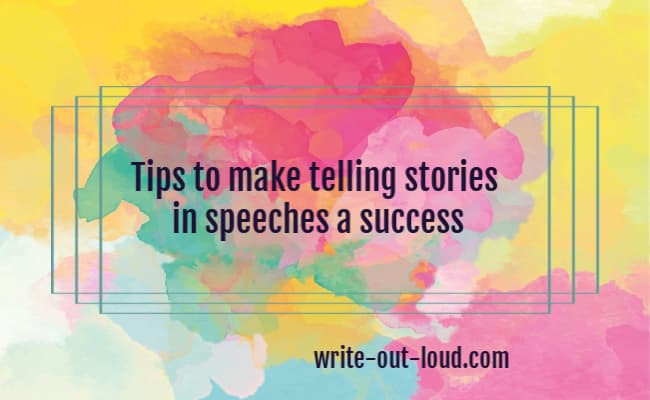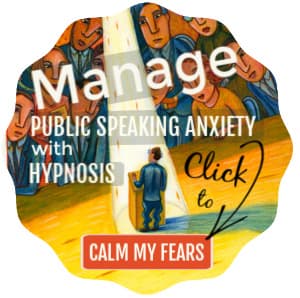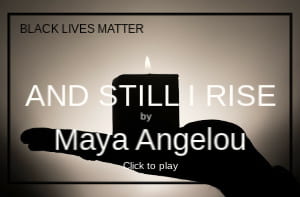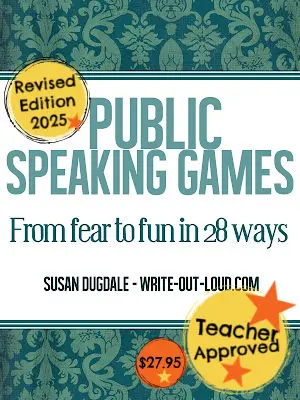- HOME ›
- Speech delivery ›
- Story telling setups
Story telling setups: what works & why
How to successfully introduce stories in speeches
By: Susan Dugdale
Some storytelling setups, (the way you lead in, or introduce a story as part of a speech), are much more successful than others.
Get it right and you'll have your audience enthralled, hanging off your every word.
Get it wrong and your audience will have turned their ears off as fast as if you'd flicked a switch.
Have you ever had a story fall flat?
If you've had the experience of a story failing to
fire, yet you know it was relevant to your audience, and your
speech, maybe the way you introduce it needs fine tuning.
The best storytelling setups sneak up on an audience capturing their
attention before they've had an opportunity to zone out. They do it without fanfare. The drums do not beat loudly. The trumpets do not herald
their arrival.
What's on this page?
Examples and discussion of what NOT to do and why
Examples of what to do - 3 sets of storytelling setup types:
More resources for storytelling including narrative speech topics
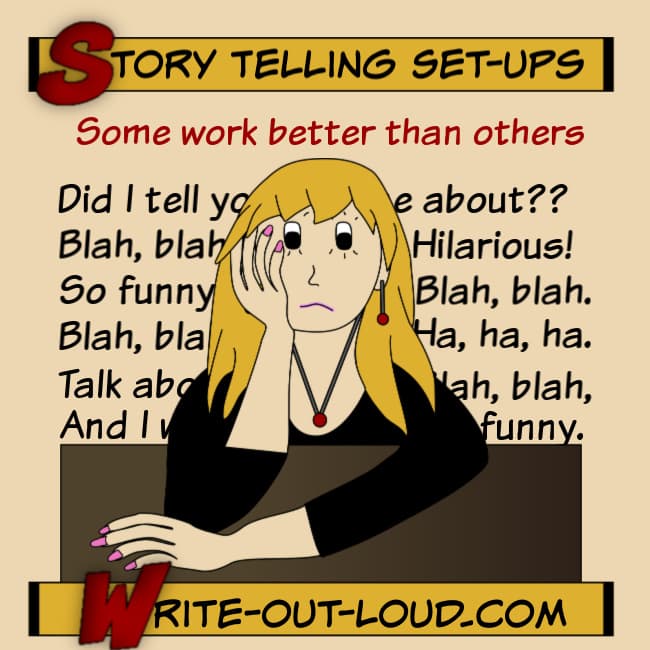
From the 'how NOT to open a story' department
Speakers who skillfully weave story telling into their speeches tend not use these introductions:
- That reminds me of a really funny story...
- Have you heard the one about ...?
- I heard a great joke the other day. You're going to love it.
- I don't know whether I should tell you this but ...
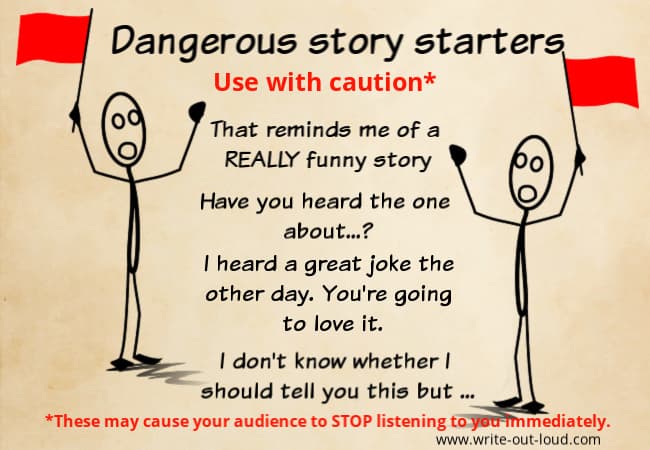
All of those introductions are dangerous. They come waving big red warning flags.
"Hey!", they shout at the audience, "There's a story coming up! I want you to be amused by it. I want you to laugh!"
What's the problem with these openings?
The problem is that they give your audience a chance to pit themselves against you. Fortunately that's not usually out loud. So they're not shouting back at you.
However in the privacy of their own minds they're beginning to wonder whether they want to listen to you.
Let me show you how it works.
That reminds me of a REALLY funny story
In the first example, "That reminds me of a really funny story", you've created several hurdles for yourself to get over before you even get to telling your story.
The first is that you have said you are, "telling a story". Your audience may interpret that as you are about to tell them something fictional, perhaps a lie, and worse, completely irrelevant.
The second hurdle is that you've told them it's "really funny".
While some people don't want to listen to "make believe", many more don't want to be told something is funny before they experience the funniness for themselves. They want to make up their own minds about what is amusing and what is not. (Thank you very much. Please don't waste my time!)
'Have you heard the one about ...?' and other gems
Using "Have you heard the one about ... ?" as an opener sets your story up as a yarn or a joke that is going the rounds.
Someone told it to me. They got it from someone else, who got it from someone else, and now I'm telling it to you. It's not personal experience, or even a new story, and therefore it can be dismissed very easily. Boring. Not original. A total turn off.
"I heard a great joke the other day ..." fits into the same slot as the starter above with the added loaded inference that the word "joke" carries. This is funny. You will laugh. Because I say so.
The last example, "I don't know whether I should tell you this ..." invites the response, "No, you shouldn't", in the mind of your audience before your story has begun.
Do you see what's happening?
So what story telling setups do work?
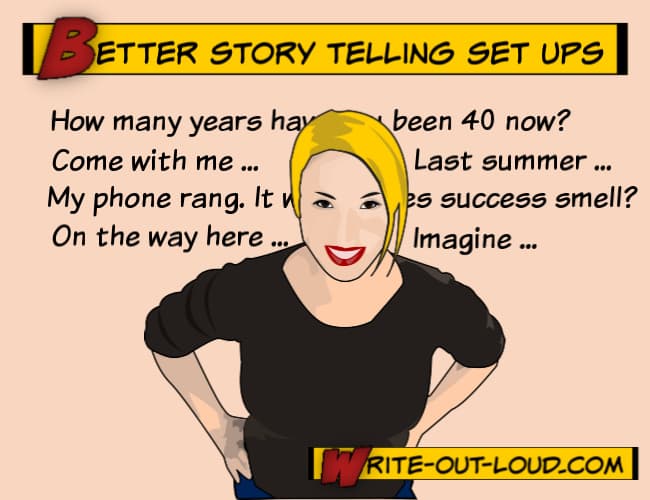
The ideal is an opener that doesn't appear to be one. It has the audience involved, listening attentively without pausing to consider whether they want to, or not.
Even though it precedes the actual story, it does not create an opportunity for the same inner resistance as the examples above do.
1. Invitations to imagine
Openers actively engaging the
audience's imagination are effective. They invite partnership, togetherness, a shared journey.
Try:
- I want you to visualize ...
- Imagine ...
- Let's step back in time ...
- Come with me ...
Do you see the difference?
2. Making it personal
Setting your story as part of your personal experience works well. These invite your audience to share an aspect of your life, to trust and to identify with you.
Consider these:
- Just yesterday I was talking with a friend ...
- On my way to work this morning ...
- My wife thinks I ...
- My phone rang. It was ...
- I was in XXXX (insert name of local shop/restaurant etc) when...
- Last summer ...
3. Rhetorical questions - silly & serious
If it fits your speech you could also experiment with story telling setups based on rhetorical questions. As well as straight or serious questions, try some obviously ridiculous ones to grab your audience's attention.
Examples of both are:
- How many years have you been 40?
- Is it true that diamonds are a girls best friend?
- Do you remember when the sky was always blue and summer was endless?
- Why is it that whenever you're late, you can never find a car park?
- Why should we care about others?
- Who decides what is fashionable and what is not?
- How come it always rains when it's holiday time?
- How come so many people are described as "average"?
Try multiple openings
When you're writing or rehearsing your speech try several setups before settling on the one you're definitely going to use. Listen for "rightness" of fit to your story, your speech, and your audience.
PS. Consider endings too
Just as there are seamless ways of entering a story, so too there are slicker ways to exist.
You do not have to announce, "By the way, that's the end of the story".
Instead try a pause, a change of tone, a shift in body language or speaking rate. All of these signal the start of a new segment without saying anything.
More about storytelling in speeches
For how to choose the right story, the benefit of sharing personal stories, and how to improve your storytelling see: storytelling in speeches.
I've also got two pages of tell-a-personal-story speech topic suggestions that are perfect for honing skills. (If you're looking for suitable topics for the Toastmasters Level 3 Storytelling project, do check these out.)
- 125 narrative speech topics -This page includes a free printable narrative speech outline.
- 60 vocal variety and body language topics.

About the Author: Susan Dugdale, founder of write-out-loud.com, is a qualified teacher of English and drama with over 40 years of experience. Drawing on her professional expertise and her personal journey from shyness to confidence, Susan creates practical, real-world resources to help people find their voice and speak with power.
